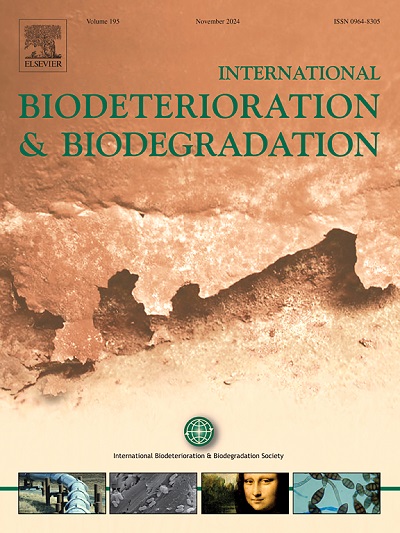蜡样芽孢杆菌C3752分离株降解荔枝羽毛的机理及其在荔枝保鲜中的潜在应用
IF 4.1
2区 环境科学与生态学
Q2 BIOTECHNOLOGY & APPLIED MICROBIOLOGY
International Biodeterioration & Biodegradation
Pub Date : 2025-02-01
DOI:10.1016/j.ibiod.2025.106000
引用次数: 0
摘要
羽毛废物是家禽业富含蛋白质的副产品,由于其顽固性,对降解和环境构成了挑战。微生物降解已成为一种很有前途的方法,但仍然需要有效的羽毛降解微生物(fdm),降解机制仍未完全了解。在这项研究中,我们鉴定了一种FDM为蜡样芽孢杆菌(C3752)。通过优化条件,菌株C3752在30 h内的羽毛降解效率达到90.5%。结构分析表明,羽毛降解可能是通过细菌定植和孔隙形成,导致结构分叉和纤维减少。此外,菌株C3752的特征产物和基因表达的变化表明,羽毛的降解可能包括三个过程:生物表面活性剂和脂肪酶水解脂质,高效半胱氨酸亚硫酸盐再生和二硫还原酶破坏二硫键,以及角蛋白水解。在羽毛降解过程中首次报道了孔隙形成和产生的生物表面活性剂。上调的代谢途径包括糖酵解、糖异生、戊糖磷酸途径和电子传递链,可能满足细胞生长和羽毛降解的能量需求。羽毛水解产物具有抗氧化和生物表面活性剂的特性,对荔枝采后保鲜有一定的作用。这些发现表明,孔隙形成、基于半胱氨酸的亚硫酸盐再生和上调的代谢途径可能是羽毛有效降解的原因。该研究为羽毛降解研究提供了新的思路和前景,并为羽毛水解物在水果保鲜中的应用开辟了新的途径。本文章由计算机程序翻译,如有差异,请以英文原文为准。

Mechanism of feather degradation by a isolated strain Bacillus cereus C3752 and potential application in litchi preservation
Feather waste, a protein-rich by-product of poultry industries, poses challenges in degradation and environment due to its recalcitrant nature. Microbial degradation has emerged as a promising approach, yet efficient feather-degrading microorganisms (FDMs) are still needed and the degradation mechanism remains not fully understood. In this study, we identified a FDM as Bacillus cereus (C3752). By optimizing conditions, strain C3752 achieved a feather degradation efficiency of 90.5% within 30 h. Structural analysis revealed that feather degradation likely occurred through bacterial colonization and pore formation, causing structural bifurcation and fiber reduction. Furthermore, changes in characteristic products and gene expression from strain C3752 indicated that feather degradation may include three processes: lipid hydrolysis by biosurfactants and lipases, disulfide bond disruption through efficient cysteine-based sulfite regeneration and disulfide reductases, and keratin hydrolysis. Pore formation and produced biosurfactants are reported for the first time during feather degradation. Up-regulated metabolic pathways including glycolysis, gluconeogenesis, pentose phosphate pathway, and electron transport chain likely meet energy demands for cell growth and feather degradation. The feather hydrolysates exhibited antioxidant and biosurfactant properties, showing a certain effect on post-harvest litchi preservation. These findings suggest that pore formation, cysteine-based sulfite regeneration and up-regulated metabolic pathways may be responsible for efficient feather degradation. This study provides a promising candidate and new insights into feather degradation, and opens the application of feather hydrolysates in fruit preservation.
求助全文
通过发布文献求助,成功后即可免费获取论文全文。
去求助
来源期刊
CiteScore
9.60
自引率
10.40%
发文量
107
审稿时长
21 days
期刊介绍:
International Biodeterioration and Biodegradation publishes original research papers and reviews on the biological causes of deterioration or degradation.

 求助内容:
求助内容: 应助结果提醒方式:
应助结果提醒方式:


